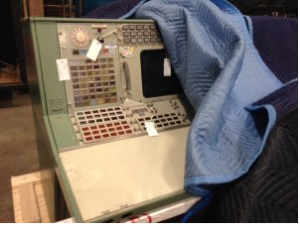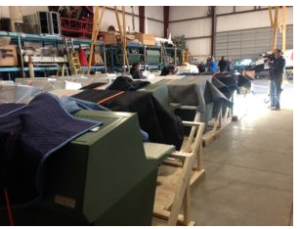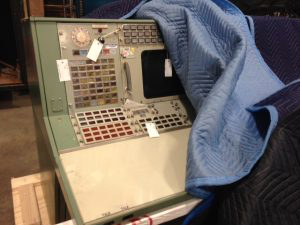
HUTCHINSON — The historic consoles used by NASA flight controllers to manage the first missions to land astronauts on the moon arrived at the Cosmosphere SpaceWorks facility in Hutchinson Monday morning.
According to a media release, the consoles are in Hutchinson for a full restoration that will last through the spring. The $5 million restoration will return Mission Operations Control Room-2 inside the Mission Control Center to how it looked at the time of Apollo 11, the first mission to land humans on the moon.
“The Mission Operations Control Room at the Johnson Space Center is the cathedral of manned space exploration” Cosmosphere CEO Jim Remar said. ”So for us to be involved in the restoration is an incredible honor.”
Space Center Houston, the visitor center for Johnson Space Center, together with NASA, Texas Historical Commission and the National Park Service are overseeing the project, with the goal of having it ready in time for the 50th anniversary of the first lunar landing next year. The Park Service gave its approval for the restoration in 2017 given the room’s status as a National Historic Landmark since 1985.
“This will be a complete and accurate historical restoration,” Sandra Tetley, historic preservation officer and real property officer at Johnson Space Center, said. “It will not be a fix-it-up. Everything will be preserved and accurate, from buttons, button labels, lighting — everything will be completely accurate.”
 Though the overall control room is being returned to its Apollo 11 appearance, the consoles will be configured to how they looked during the fourth moon landing in July 1971. The Apollo 15 mission included the first use of the lunar roving vehicle (lunar rover) and began the extended exploration of the moon.
Though the overall control room is being returned to its Apollo 11 appearance, the consoles will be configured to how they looked during the fourth moon landing in July 1971. The Apollo 15 mission included the first use of the lunar roving vehicle (lunar rover) and began the extended exploration of the moon.
SpaceWorks will carefully take apart the more than half-century old consoles in order to bring them back to life.
First used for NASA’s Gemini 4 mission in 1965 and retired after STS-53, the 52nd space shuttle mission in December 1992, the consoles’ electronics are largely no longer serviceable. As such, the displays and some of the other visible elements will be augmented with modern components in order to create the appearance that the consoles are operational.
